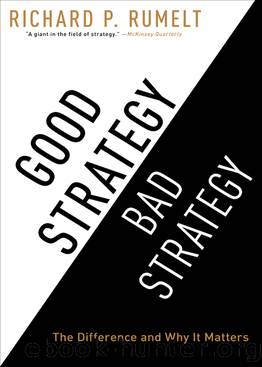Good Strategy Bad Strategy by Richard Rumelt

Author:Richard Rumelt [Rumelt, Richard]
Language: eng
Format: epub
ISBN: 978-0-307-88625-5
Publisher: Crown Publishing Group
Published: 2011-07-18T16:00:00+00:00
The problem with engineering growth by acquisition is that when you buy a company, especially a public company, you usually pay too much. You pay a premium over its ordinary market value—usually about 25 percent—plus fees. If you have friendly investment bankers and lenders, you can grow as fast as you like by acquisition. But unless you can buy companies for less than they are worth, or unless you are specially positioned to add more value to the target than anyone else can, no value is created by such expansion.
Corporate leaders seek growth for many reasons. They may (erroneously) believe that administrative costs will fall with size. A poor, but common, reason for acquisitions is to move key executives to the periphery rather than let them go. The leaders of larger firms tend to be paid more. And, in a decentralized company, making acquisitions is a lot more fun than reading reports on divisional performance. In addition to all these reasons, key corporate advisers—investment bankers, consultants, mergers and acquisitions law firms, and anyone who can claim a “finder’s fee”—can earn a king’s ransom by being “helpful” in a major deal.
In 1998, I was retained by Telecom Italia as a special consultant on strategy. Telecom Italia was then the fifth largest fixed-line telecommunications operator and Europe’s largest and most innovative mobile operator. It had been privatized in a series of steps beginning in 1994 and ending in the sale of public shares in 1997.
At that moment the strategic problems facing traditional fixed-line European operators were considerable. Many still earned the juicy gross margins typical of monopoly national carriers, but the future held the possibility of dramatically increased competition and technological change. Deregulation was allowing foreign entry into national markets, and the Internet was blossoming. Companies such as Telecom Italia had large cash flows based on past investments, and a critical issue was where to invest those cash flows. More fixed lines seemed unwise. Optical fiber rings around cities looked promising, but three foreign firms already had plans for regional centers like Milan. Competing against them would simply cannibalize existing business revenue. The Internet was growing rapidly, but income was small—its growth was based on very low prices, much lower than those charged for voice or traditional data traffic.
The chairman and CEO, Gianmario Rossignolo, had been talking about an alliance with Cable & Wireless, a company begun in the nineteenth century as a provider of undersea telegraph links across the British Empire. Nationalized in 1947, it had been reprivatized in 1981 by Margaret Thatcher. Cable & Wireless CEO Richard Brown was an American, brought in to break an internal political logjam that had kept the company operating like a set of independent fiefdoms. Brown had been seeking a major alliance, first flirting with British Telecom, then AT&T, then Sprint. The (fluffy) argument was that telecommunications was globalizing and that there would be value in a global brand.
Brown and Rossignolo had begun their alliance discussions with talk of a series of cross holdings in France, the Caribbean, and other locations.
Download
This site does not store any files on its server. We only index and link to content provided by other sites. Please contact the content providers to delete copyright contents if any and email us, we'll remove relevant links or contents immediately.
Time Management Made Easy: How to Cultivate New Habits, Improve Productivity and Get Things Done by Joshua Strachan(2388)
The 7 Habits of Highly Effective People by Stephen R. Covey & Sean Covey(2196)
The Concise Laws of Human Nature by Robert Greene(1802)
Doesn't Hurt to Ask by Trey Gowdy(1602)
Primal Leadership by Daniel Goleman(1215)
Hook Point: How to Stand Out in a 3-Second World by Brendan Kane(1162)
HBR's 10 Must Reads 2021 by unknow(1071)
Don't Sweat the Small Stuff...and It's All Small Stuff by Richard Carlson(1067)
Amazon Unbound by Brad Stone(1010)
100 Things Successful People Do by Nigel Cumberland(996)
HBR's 10 Must Reads 2021 by Harvard Business Review(980)
Master of One by Jordan Raynor(969)
The Job Closer by Steve Dalton(968)
Lives of the Stoics by Ryan Holiday & Stephen Hanselman(934)
Declutter Your Mind: A step by step guide to learn to control your thoughts, stop worrying, relieve anxiety and eliminate panic attacks and negative thinking by Mia Chandler(917)
The Power of 100! by Shaun King(908)
Conflicted by Ian Leslie(833)
Coders at Work: Reflections on the craft of programming by Peter Seibel(817)
The Book of Hope by Jane Goodall(803)
